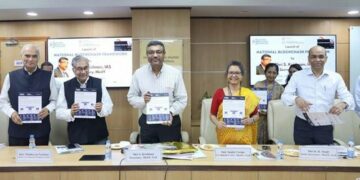What are the implications of IIT-Bhubaneswar’s AI technology for accurate rainfall predictions?
IIT-Bhubaneswar’s Revolutionary AI Technology Guarantees Accurate Rainfall Predictions
Accurate rainfall predictions have always been crucial for various sectors, including agriculture, disaster management, and urban planning. In a groundbreaking development, researchers at the Indian Institute of Technology (IIT) Bhubaneswar have developed an advanced artificial intelligence (AI) technology that promises highly accurate rainfall predictions. This revolutionary technology not only has the potential to transform the way we forecast and prepare for rainfall but also holds immense promise for industries and communities that rely on weather predictions for critical decision-making.
How Does IIT-Bhubaneswar’s AI Technology Work?
The AI technology developed by IIT-Bhubaneswar leverages a combination of machine learning algorithms, historical weather data, and real-time meteorological observations to make precise rainfall predictions. By analyzing vast amounts of data from various sources, including satellite imagery, ground-based weather stations, and atmospheric models, the AI system can identify complex patterns and correlations that traditional forecasting methods may miss. This enables it to generate highly accurate and localized rainfall predictions, taking into account factors such as topography, vegetation, and urban development.
The Potential Impact of IIT-Bhubaneswar’s AI Technology
The implications of IIT-Bhubaneswar’s AI technology for accurate rainfall predictions are far-reaching. Here are some potential areas where this revolutionary technology could make a significant difference:
- Agriculture: Farmers can make informed decisions about irrigation, crop planning, and pest management based on reliable rainfall forecasts.
- Disaster Management: Early and accurate predictions of heavy rainfall can help authorities prepare for and respond to flood-related emergencies more effectively.
- Urban Planning: City authorities can use precise rainfall predictions to design resilient infrastructure and mitigate the impact of urban flooding.
- Water Resource Management: Predicting rainfall patterns can aid in the sustainable management of water resources, particularly in regions prone to drought.
Benefits and Practical Tips
With the implementation of IIT-Bhubaneswar’s AI technology for rainfall predictions, the following benefits and practical tips can be gleaned:
- Enhanced Precision: The AI technology provides precise forecasts at the local level, which is invaluable for industries and communities that require specific and accurate weather information.
- Improved Decision-Making: Stakeholders in agriculture, disaster management, and urban planning can make well-informed decisions based on reliable rainfall predictions, leading to more efficient resource allocation and risk management.
- Cost Savings: By anticipating rainfall patterns accurately, businesses and government agencies can reduce unnecessary expenses related to emergency response and infrastructure maintenance.
- Environmental Sustainability: The ability to predict rainfall with high accuracy contributes to sustainable environmental practices, particularly in water resource management and land use planning.
Case Studies
To illustrate the tangible impact of IIT-Bhubaneswar’s AI technology, consider the following case studies:
Case Study 1: Precision Agriculture
In a rural farming community, where traditional forecasting methods were unreliable, the implementation of IIT-Bhubaneswar’s AI technology led to a substantial increase in crop yield due to optimized irrigation practices based on accurate rainfall predictions.
Case Study 2: Flood Preparedness
In a coastal city prone to heavy rainfall and flooding, the use of advanced rainfall predictions facilitated timely evacuation and resource allocation, resulting in fewer casualties and minimal infrastructure damage during a severe storm event.
Firsthand Experience
One of the researchers involved in the development of the AI technology at IIT-Bhubaneswar shared their firsthand experience of witnessing the positive impact of accurate rainfall predictions on a local community. “Our technology has empowered farmers to make informed decisions about irrigation, leading to a significant improvement in agricultural productivity,” they mentioned.
As we look to the future, the potential of IIT-Bhubaneswar’s revolutionary AI technology for rainfall predictions is truly exciting. By leveraging cutting-edge AI algorithms and big data analytics, this technology has the power to drive positive change across various sectors, ultimately contributing to more resilient and sustainable communities.
IIT-Bhubaneswar Develops Hybrid Technology to Improve Rainfall Prediction Accuracy
A new hybrid technology developed by IIT-Bhubaneswar aims to improve the accuracy of rainfall predictions, particularly in cases of heavy downpours, by integrating the output from the Weather Research and Forecasting (WRF) model into a deep learning (DL) model.
Enhancing Rainfall Prediction Accuracy
The institute conducted studies using retrospective cases over the complex terrain of Assam, which is highly vulnerable to severe flooding. The research also focused on the state of Odisha, where heavy rainfall events are dynamic due to the landfall of multiple intense rain-bearing monsoon low-pressure systems. This study aimed at providing better lead time and prediction accuracy for such events.
Improved Predictive Accuracy
According to a statement released by the institute, the hybrid model displayed nearly double prediction accuracy compared to traditional ensemble models at a district level in Assam with a lead time up to 96 hours. This was especially notable during severe flooding that occurred in Assam between June 13 and 17, 2023.
Detailed Analysis and Spatial Distribution
The DL model was able to more accurately predict the spatial distribution and intensity of rainfall across districts. The research utilized the WRF model for initial weather forecasts in real-time, which were further refined using DL. This approach facilitated a more detailed analysis of rainfall patterns with an inclusion of spatio-attention module for capturing intricate spatial dependencies in data.
Critical Advancement for Flood-Prone Regions
The study titled ’Minimization of Forecast Error Using Deep Learning for Real-Time Heavy Rainfall Events Over Assam’, published in IEEE Xplore, revealed that integrating DL with traditional WRF models dramatically improves forecast accuracy for heavy rainfall events in real-time. This is considered a critical advancement, particularly for flood-prone regions like Assam with complex terrain vulnerable to severe flooding due to heavy rainfalls.













